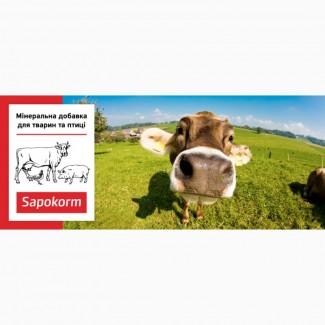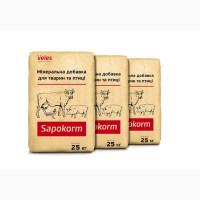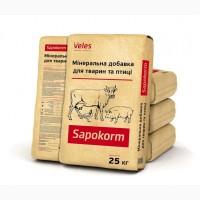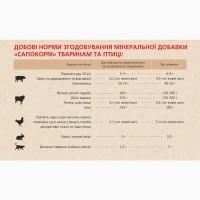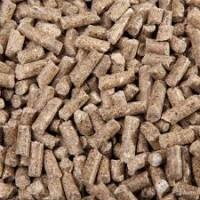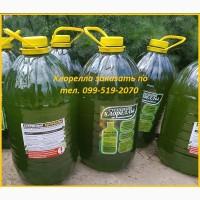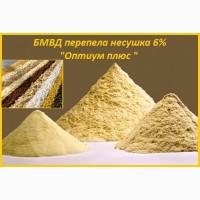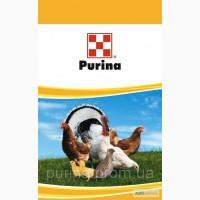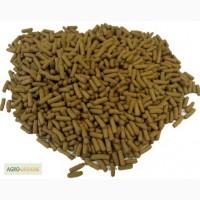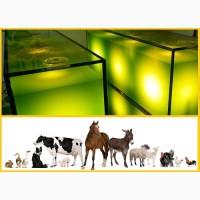/ Forage, mixed feed, supplements / Combined feed / Sapokorm - mineral therapeutic and preventive...
Sell / buy
Sapokorm - mineral therapeutic and preventive supplement for cattle feed, Khmelnytskyi region.
Region:all of Ukraine,
Khmelnytska region.
(Slavuta)
Updated:
"SAPOKORM" - MINERAL ADDITIVE FOR FEEDCAWN!
One of the main prerequisites for increasing the productivity of farm animals is their complete mineral nutrition.
Forages satisfy the need of highly productive animals in mineral elements by only 30-50%. As a rule, their lack of abundance is compensated by mineral additives in compound feed, premixes, protein-vitamin mineral additives and mixtures. The use of mineral additives is one of the factors of increasing the productivity of animals.
The company "NATURAL MINERALS" offers to use SAPOKORM as a mineral supplement for cattle feed.
SAPOKORM is a completely natural preparation without any additives and preservatives and does not contain toxic elements and allergens. The product is made from a natural dispersed mineral of the montmorillonite group of trioctahedral magnesium smectite without artificial addition of macro- and microelements.
The use of SAPOKORM ensures that animals receive a unique naturally balanced complex of vital macro- and microelements, in particular, magnesium, silicon, iron, zinc, etc., and normalizes their balance.
Thanks to the special natural combination of macro- and microelements in its composition, SAPOKORM has high adsorption, cation exchange, catalytic and detoxification properties that improve the metabolism and productivity of animals.
The use of SAPOKORM contributes to the increase of milk and meat productivity of cattle, reproductive capacity of cows, increase of assimilation of nitrogen, phosphorus and certain trace elements in the animal's body.
SAPOKORM, when fed to dry cows and dairy cows, improves their reproductive capacity, which is manifested in a decrease in the period of first insemination by 7-19 days, service period - by 24-31 days, increases the percentage of fat cows up to the 90th day after calving by 24-30 , and also contributes to the reduction of litter retention by 20% and endometritis diseases by 1.5-2.2 times, increases the preservation of calves by 11.8% and the reproductive capacity of cows and milk productivity - by 11.8-17%.
Long-term feeding of cattle with SAPOKORM at the rate of 15 g per 1 kg. ration helps to increase average daily gains from 7.3 to 18.8% and reduces feed consumption per unit of gain by 6.8-15.3%.
When fed to animals, SAPOKORM increases the digestibility of fat by 4.3 and 3.8%, protein by 3.9%, as well as the retention of nitrogen, calcium, phosphorus, iron and manganese in the animal's body.
The State Department of Veterinary Medicine, the State Research Control Institute of Veterinary Medicines and the Institute of Feed and Agriculture of the Podillia Branch of the National Academy of Sciences of Ukraine recommend the use of SAPOKORM as a mineral additive for fattening farm animals, as well as as a component in the production of compound feed and premixes (Guidelines for the use of SAPOKORM dated 04/30/2003 No. 15-14/187 and dated 04/24/2015 No. 13-02/352).
SAPOKORM is recommended for:
- increase in meat and dairy productivity;
- preservation of young cattle from diseases and death;
- reduction of the culling rate and increase of the reproductive function;
- removal of toxins, pathogenic microorganisms, bacteria and some types of viruses from the gastrointestinal tract of cattle;
- purification of the animal body from salts of heavy metals and radionuclides;
- improvement of immunity and stabilization of metabolism;(//tractor-service.com)
- improvement of animal appetite and assimilation of nutrients;
- strengthening of the musculoskeletal system;
- prevention and treatment of ketosis, microelementosis, parakeratosis, dysentery and fodder diarrhea, gastroenteritis and other diseases.
SAPOKORM is added to the composition of dry, loose, granular and wet mixtures and premixes with thorough mixing for the purpose of uniform distribution throughout the entire mass of feed.
The following rates of feeding SAPOKORM are recommended:
- Cattle - 100 g/day or 36-37 kg per bull per year;
- For lactating cows -150 g/day or 55 kg per cow per year;
- For calves, goats and sheep - 0.2 g/kg of live weight.
When treated with SAPOKORM for 3 to 10 days, the prophylactic dose increases by 1.5-2 times.
Feeding SAPOKORM in the recommended doses for each species of animal can be started after the transfer of young animals to independent consumption of feed and before slaughter.
Since SAPOKORM does not contain toxic elements and impurities, and as a sorbent removes heavy metal salts and radionuclides from the animal's body, it is recommended to constantly feed the mineral complex without limiting its use in time.
The use of SAPOKORM allows you to get a specific result - increase in growth, milk yield, decrease in the death rate of young animals, while saving money on the purchase of premixes and mycosorbents. The effect obtained from the use of SAPOKORM in the field of meat and dairy products is significantly superior to the results of the use of other minerals.
SAPOKORM is universal and can be used in the breeding of breeding and dairy cows, calves, sheep, goats, horses and other animals.
In addition, SAPOKORM removes metabolic products from the animal's body and is an alternative to veterinary drugs in the treatment of many diseases.
The use of mineralSAPOKORM additive allows you to solve several important tasks in cattle breeding at once. Firstly, the economic feasibility of keeping cattle increases due to high rates of weight gain. Secondly, feed costs for live weight gain are reduced. Thirdly, production becomes more competitive due to ecologically clean and safe for human health milk and meat.
There are no contraindications. Adverse reactions when using SAPOKORM were not detected. Cases of overdose were not reported.
The shelf life is 3 years from the date of manufacture. The batch number and date of manufacture are indicated on the package.
Safety, quality, compliance of the product with standards and technical conditions in terms of toxicity, content of radionuclides and toxic elements, confirmed by the Conclusion of the State SES of Ukraine dated 04/08/2016. No. 05.03.02.-04/11905, by Expert opinion No. 004025 d.k./16 dated 08.08.2016. Khmelnytskyi RGLVM of the State Veterinary and Phytosanitary Service of Ukraine, Conclusion of the Institute of Experimental and Clinical Veterinary Medicine of the National Academy of Sciences of Ukraine dated 06/15/2015. No. 491.
Produced according to TU U 10.9-21314234-001:2012.
One of the main prerequisites for increasing the productivity of farm animals is their complete mineral nutrition.
Forages satisfy the need of highly productive animals in mineral elements by only 30-50%. As a rule, their lack of abundance is compensated by mineral additives in compound feed, premixes, protein-vitamin mineral additives and mixtures. The use of mineral additives is one of the factors of increasing the productivity of animals.
The company "NATURAL MINERALS" offers to use SAPOKORM as a mineral supplement for cattle feed.
SAPOKORM is a completely natural preparation without any additives and preservatives and does not contain toxic elements and allergens. The product is made from a natural dispersed mineral of the montmorillonite group of trioctahedral magnesium smectite without artificial addition of macro- and microelements.
The use of SAPOKORM ensures that animals receive a unique naturally balanced complex of vital macro- and microelements, in particular, magnesium, silicon, iron, zinc, etc., and normalizes their balance.
Thanks to the special natural combination of macro- and microelements in its composition, SAPOKORM has high adsorption, cation exchange, catalytic and detoxification properties that improve the metabolism and productivity of animals.
The use of SAPOKORM contributes to the increase of milk and meat productivity of cattle, reproductive capacity of cows, increase of assimilation of nitrogen, phosphorus and certain trace elements in the animal's body.
SAPOKORM, when fed to dry cows and dairy cows, improves their reproductive capacity, which is manifested in a decrease in the period of first insemination by 7-19 days, service period - by 24-31 days, increases the percentage of fat cows up to the 90th day after calving by 24-30 , and also contributes to the reduction of litter retention by 20% and endometritis diseases by 1.5-2.2 times, increases the preservation of calves by 11.8% and the reproductive capacity of cows and milk productivity - by 11.8-17%.
Long-term feeding of cattle with SAPOKORM at the rate of 15 g per 1 kg. ration helps to increase average daily gains from 7.3 to 18.8% and reduces feed consumption per unit of gain by 6.8-15.3%.
When fed to animals, SAPOKORM increases the digestibility of fat by 4.3 and 3.8%, protein by 3.9%, as well as the retention of nitrogen, calcium, phosphorus, iron and manganese in the animal's body.
The State Department of Veterinary Medicine, the State Research Control Institute of Veterinary Medicines and the Institute of Feed and Agriculture of the Podillia Branch of the National Academy of Sciences of Ukraine recommend the use of SAPOKORM as a mineral additive for fattening farm animals, as well as as a component in the production of compound feed and premixes (Guidelines for the use of SAPOKORM dated 04/30/2003 No. 15-14/187 and dated 04/24/2015 No. 13-02/352).
SAPOKORM is recommended for:
- increase in meat and dairy productivity;
- preservation of young cattle from diseases and death;
- reduction of the culling rate and increase of the reproductive function;
- removal of toxins, pathogenic microorganisms, bacteria and some types of viruses from the gastrointestinal tract of cattle;
- purification of the animal body from salts of heavy metals and radionuclides;
- improvement of immunity and stabilization of metabolism;(//tractor-service.com)
- improvement of animal appetite and assimilation of nutrients;
- strengthening of the musculoskeletal system;
- prevention and treatment of ketosis, microelementosis, parakeratosis, dysentery and fodder diarrhea, gastroenteritis and other diseases.
SAPOKORM is added to the composition of dry, loose, granular and wet mixtures and premixes with thorough mixing for the purpose of uniform distribution throughout the entire mass of feed.
The following rates of feeding SAPOKORM are recommended:
- Cattle - 100 g/day or 36-37 kg per bull per year;
- For lactating cows -150 g/day or 55 kg per cow per year;
- For calves, goats and sheep - 0.2 g/kg of live weight.
When treated with SAPOKORM for 3 to 10 days, the prophylactic dose increases by 1.5-2 times.
Feeding SAPOKORM in the recommended doses for each species of animal can be started after the transfer of young animals to independent consumption of feed and before slaughter.
Since SAPOKORM does not contain toxic elements and impurities, and as a sorbent removes heavy metal salts and radionuclides from the animal's body, it is recommended to constantly feed the mineral complex without limiting its use in time.
The use of SAPOKORM allows you to get a specific result - increase in growth, milk yield, decrease in the death rate of young animals, while saving money on the purchase of premixes and mycosorbents. The effect obtained from the use of SAPOKORM in the field of meat and dairy products is significantly superior to the results of the use of other minerals.
SAPOKORM is universal and can be used in the breeding of breeding and dairy cows, calves, sheep, goats, horses and other animals.
In addition, SAPOKORM removes metabolic products from the animal's body and is an alternative to veterinary drugs in the treatment of many diseases.
The use of mineralSAPOKORM additive allows you to solve several important tasks in cattle breeding at once. Firstly, the economic feasibility of keeping cattle increases due to high rates of weight gain. Secondly, feed costs for live weight gain are reduced. Thirdly, production becomes more competitive due to ecologically clean and safe for human health milk and meat.
There are no contraindications. Adverse reactions when using SAPOKORM were not detected. Cases of overdose were not reported.
The shelf life is 3 years from the date of manufacture. The batch number and date of manufacture are indicated on the package.
Safety, quality, compliance of the product with standards and technical conditions in terms of toxicity, content of radionuclides and toxic elements, confirmed by the Conclusion of the State SES of Ukraine dated 04/08/2016. No. 05.03.02.-04/11905, by Expert opinion No. 004025 d.k./16 dated 08.08.2016. Khmelnytskyi RGLVM of the State Veterinary and Phytosanitary Service of Ukraine, Conclusion of the Institute of Experimental and Clinical Veterinary Medicine of the National Academy of Sciences of Ukraine dated 06/15/2015. No. 491.
Produced according to TU U 10.9-21314234-001:2012.
|
Author, contacts | |
Evheny Kubrak / отзывы, инфо. / activity evaluation | |
|
Phone:
(096xxxxxx
show
| |
| https://sapokorm.prom.ua/product_list | |
| facebook.com/Sapokorm | |
All user ads ~7 | |
Ad ID : #284139
(added by a registered user, registration date: 25-07-2014)
Added/Updated: 31-08-2024 11:58 (current, until: 31-08-2025)
Permanent ad address:
Showed / watched for today: ?, total: ?
